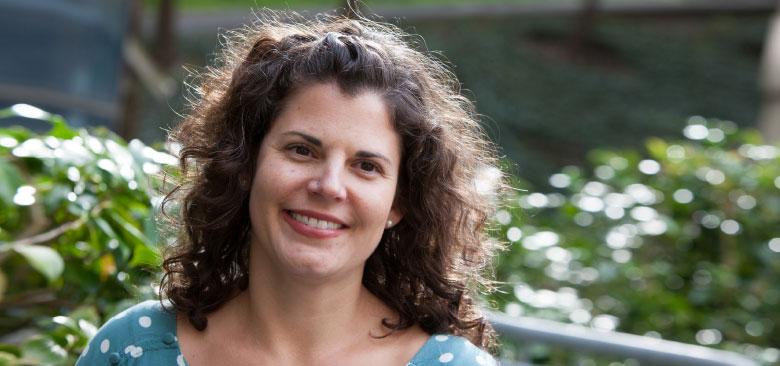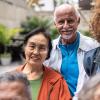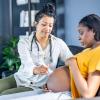
Elena Flowers (photo and video by Elisabeth Fall)
Getting the Results: A Personal Genomics Journey, Part Two
When I applied for Chancellor’s Faculty Development Funds to have my whole genome sequenced, my primary motivation was to understand this process and share the experience with my students. As a genomics researcher charged with teaching the topic to advanced practice nursing students, I want them to be as prepared as possible should they encounter patients anxious for interpretation of direct-to-consumer genetic tests.
It seems likely that they will encounter such patients. One example: The company offering my test requires that a clinician sign the orders and receive my results. Thankfully, my faculty colleague Heather Leutwyler is both a researcher and a nurse practitioner and could fulfill the requirement. I was sure her expertise – and that of many other colleagues at the UC San Francisco School of Nursing – would add a lot to the understanding I was seeking.
Discussing the Results with My NP and Others
When Heather received my results, she forwarded them to me, and I quickly ripped open the envelope and skimmed through the first seven pages, called a “Clinical Predisposition Report.” Thankfully, I don’t have any pathogenic or likely pathogenic variants, though I am a carrier for two rare conditions. This initially raised concerns about my two daughters, but I quickly reminded myself they were born alive and healthy and are now 6 and 3, without any unusual symptoms or signs, so they must not have inherited a second risk allele. Someone without my training, however, might not be able to find such comfort – at least not at first. And had I received these results before I became pregnant, I might have been considerably more concerned.
I also received a pharmacogenetics report, which provides information about how well I metabolize 16 drugs. This seemed more useful than the Clinical Predisposition Report. As a cardiac nurse, I immediately noticed that I’m a poor metabolizer of warfarin based on my CYP2C9 genotype and have low sensitivity to warfarin based on my VKORC1 genotype. If I develop atrial fibrillation and need prophylactic anticoagulation, this would be important information for my providers.
It might also have implications for prevention. For example, knowing that I’m a poor metabolizer of the most widely used anticoagulant makes following basic heart-healthy habits especially important. In particular, I should watch my blood pressure (I do have a family history of hypertension), stay physically active yet avoid extreme physical activity and stick to moderate alcohol intake. The broader point is that if I found myself in the position of needing any of the listed drugs, there likely would be clear clinical and, perhaps, preventive actions to take based on my specific genotype. And, in fact, many have referred to pharmacogenetics as the “low-hanging fruit” for incorporation of genomics into clinical practice.
Upon reading my results, Heather had a similar initial reaction to mine. But she then considered how she might prepare to counsel a patient without my background about these results. Heather does research on neurologic disease, so she immediately looked to see whether I was tested for the APOE gene, which is associated with increased risk for Alzheimer’s disease. The APOE result isn’t included in the Clinical Predisposition Report, but because of her background, Heather felt she would be comfortable counseling patients about such a result. Beyond that, however, she felt there wasn’t a lot in the report she could effectively counsel her patients about. She also did not necessarily feel that she had been trained or had thought much about how to counsel any patient about what these types of findings mean.
I then spoke with my colleague Kord Kober, who carries out research using large genetic data sets. He was surprised that I didn’t have any risk factors for type 2 diabetes, cancers, heart disease or other common conditions, and suddenly I was a bit confused myself. The report looked at 6,962 specific variants in 1,690 genes, most associated with rare diseases, but offered nothing that I could see or understand about my risk for common, complex conditions. And if I was confused, as a genomics researcher and health care provider talking this over with colleagues who are health care providers, geneticists and researchers, how would a typical patient respond? What utility would they find in the report? These questions made me that much more anxious to attend the company’s optional daylong seminar, at which genomics experts would speak. Maybe some of these questions would be addressed there.
The Seminar
With its engaging speakers and 38 other participants – most of whom were health care providers or researchers – the seminar felt at first a lot like any scientific meeting. It was after lunch, at an hourlong working session in which we learned how to log in to a web-based application and begin to interrogate our own genomes, that things began to feel different.
For one, as a scientist, I was undeniably excited to see a graphic representation of my own chromosomes, a picture of the molecular me that allows me to zoom in to view my exact genetic sequence, nucleotide by nucleotide. But much more significantly, I had a very sudden and drastic realization that, via my laptop, I was holding a Pandora’s box.
The APOE gene? The answer is right there waiting for me. With a quick review of the literature and identification of the specific genetic location to view, I’d have my answer. And this is simply one example of a well-studied gene associated with a condition that occurs typically at an age older than I am now. Almost immediately, it occurred to me that for any new study associating any given genetic loci with any given disease, I have the capability to know my risk status.
Because I have training in research and genomics, I understand the limitations to the conclusions I could make based on this information, but it could send your average patient into an emotional tailspin – or make them feel unrealistically safe. In fact, I haven’t looked at my APOE genotype. I’m not sure I want to know. It’s not quite keeping me up at night, but it’s a question that I continue to consider.
And yet, being able to ask such questions is a remarkable experience. It is – as many suggest about genomics technology – empowering. Not only is the information sitting there today, but it will be available to me and my providers in 10 or 20 years, when we may know more about the implications of a given genetic variant and have new prevention or treatment strategies.
So there’s this tension between the difficult questions that having my genetic information poses and the excitement of having it. Maybe that tension explains many of the people I met that day. I ate lunch with two people who paraglide. I met a physician who works in an emergency room at a ski resort and another who works in a decompression clinic near popular diving sites. Perhaps opening one’s own biologic Pandora’s box attracts a particular type of scientist: those who are comfortable with risk and less concerned about the implications.
Now, a couple of weeks later, I’ve begun to conceptualize the numerous considerations and challenges involved with increasingly accessible genomic sequencing.
First, there’s the patient experience, wrestling with what they want to know, should know, should tell other family members. Next, we have the providers charged with guiding patients through interpretation and possibly clinical action; many of these providers may lack the training and experience to offer expert advice. Then there are the systems: data storage, data security, how to interface with large and unwieldy data sets and integrate that information with the large, unwieldy data sets of the electronic health record.
Finally, floating around those three layers are the countless societal and ethical considerations. What does having this information mean, both for individuals and for society, and how should society manage this information? There are no easy answers to any of these questions, but in the weeks and month ahead, I will speak further with those who are exploring them in depth.
Elena Flowers is an assistant professor in the UCSF School of Nursing. Her program of research is focused on identification of novel molecular markers associated with cardiovascular disease (CVD) risk factors and responses to risk reduction interventions among racial minority groups. She published numerous papers describing CVD risk in South Asians, which led to current studies evaluating microRNAs as prodromal predictors of progression to CVD and type 2 diabetes. Presently, she is investigating microRNAs as predictors of responses to behavioral interventions to reduce risk (e.g., weight loss, physical activity, yoga). Her research has expanded to include high-risk Filipino and Latino populations. She is director of the School’s genomics laboratory and Genomics Minor. She is also active in the American Heart Association, the American Diabetes Association, the Preventive Cardiovascular Nurses Association and the International Society of Nurses in Genetics.



